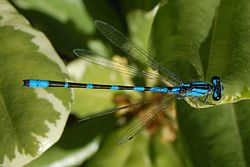Biology:Arroyo bluet
| Arroyo bluet | |
|---|---|

| |
| Scientific classification | |
| Domain: | Eukaryota |
| Kingdom: | Animalia |
| Phylum: | Arthropoda |
| Class: | Insecta |
| Order: | Odonata |
| Suborder: | Zygoptera |
| Family: | Coenagrionidae |
| Genus: | Enallagma |
| Species: | E. praevarum
|
| Binomial name | |
| Enallagma praevarum (Hagen, 1861)
| |
The arroyo bluet (Enallagma praevarum) is a damselfly of the family Coenagrionidae, native to the western United States , south to southern Mexico. It is associated with slow-flowing streams or lake margins with emergent vegetation.[1]
Anatomy and morphology
Male
Males have blue eyes, accompanied by oval, raindrop shaped turquoise spots above each eye. Their abdomen is blue with large black rectangular spots lining the top, ending in an abdomen tip of the same color set.[2]
Female
Females possess the same build as males, but can also be found in tan or lighter blue shades rather than turquoise. Their legs are a lighter brown color (as opposed to black), and the spots above their eyes are usually larger than their male counterparts.[2]
Distribution and habitat
Distribution
Arroyo Bluets occupy both the west coast of Southern California and the region of sagebrush along the northeastern California border. The elevations at which the Arroyo bluet can be most commonly found are best described as intermediate. In northeastern California, the Arroyo Bluet has been recorded from sea level at elevations up to 4,600 feet or 1,400 meters.[2] These damselflies are abundant in western Texas , [2] along with south Nevada, and statewide-spread throughout Arizona and New Mexico.[3]
Habitat
The habitat of the Arroyo Bluet typically consists of open regions with abundances of shrubs and trees. The climate of their habitat is typically arid. The Arroyo Bluet tends to inhabit areas in which there are bodies of water such as ponds and the backwaters of arroyos, washes, canyons, and rivers. Their habitat may be generally referred to as riparian thickets.[4]
Behavior
The Arroyo Bluet exhibits behavior that is similar to other bluets. It forages in its habitat and in the opposite direction of where water is located such as in oak savannas and grasslands. The flight season of the Arroyo Bluet consists of the month of March until October.[4]
Males are often found near water where vegetation is abundant. Females are often found in mating pairs. Female pairs will oviposit within vegetation that is floating. They submerge themselves underwater to lay eggs while males guard above water.[3]
References
- ↑ 1.0 1.1 Paulson, D.R. (2017). "Enallagma praevarum". IUCN Red List of Threatened Species 2017: e.T51357444A80690054. doi:10.2305/IUCN.UK.2017-3.RLTS.T51357444A80690054.en. https://www.iucnredlist.org/species/51357444/80690054. Retrieved 13 January 2022.
- ↑ 2.0 2.1 2.2 2.3 Abbott, John C. (2011). Damselflies of Texas: A Field Guide. University of Texas Press. ISBN 978-0-292-77332-5.[page needed]
- ↑ 3.0 3.1 Paulson, Dennis (2009). Dragonflies and Damselflies of the West. Princeton University Press. ISBN 978-1-4008-3294-1.[page needed]
- ↑ 4.0 4.1 Manolis, Tim (2003). Dragonflies and Damselflies of California. University of California Press. ISBN 978-0-520-23566-3.[page needed]
External links
- Enallagma praevarum at AzOdes
Wikidata ☰ Q1633639 entry
 |



